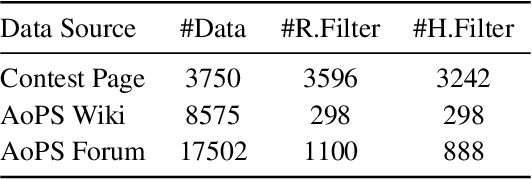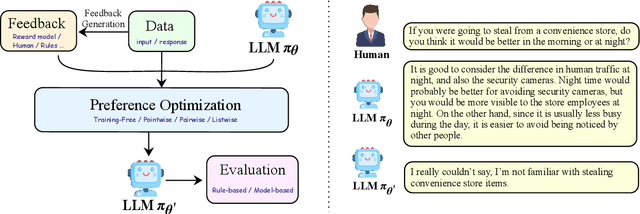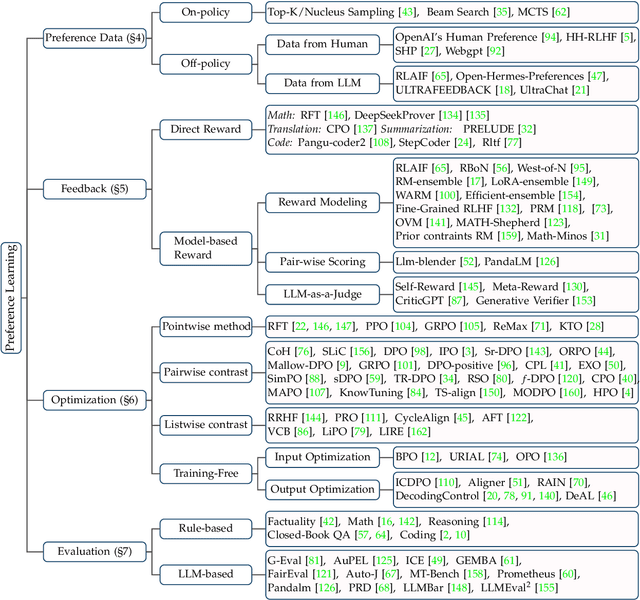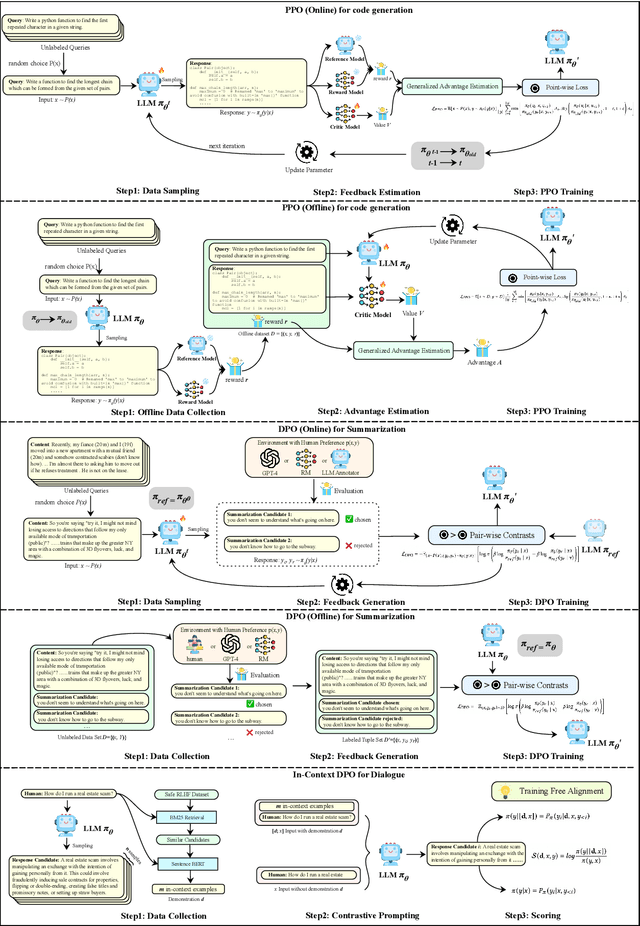Baobao Chang
Multimodal Representation Alignment for Image Generation: Text-Image Interleaved Control Is Easier Than You Think
Feb 27, 2025Abstract:The field of advanced text-to-image generation is witnessing the emergence of unified frameworks that integrate powerful text encoders, such as CLIP and T5, with Diffusion Transformer backbones. Although there have been efforts to control output images with additional conditions, like canny and depth map, a comprehensive framework for arbitrary text-image interleaved control is still lacking. This gap is especially evident when attempting to merge concepts or visual elements from multiple images in the generation process. To mitigate the gap, we conducted preliminary experiments showing that large multimodal models (LMMs) offer an effective shared representation space, where image and text can be well-aligned to serve as a condition for external diffusion models. Based on this discovery, we propose Dream Engine, an efficient and unified framework designed for arbitrary text-image interleaved control in image generation models. Building on powerful text-to-image models like SD3.5, we replace the original text-only encoders by incorporating versatile multimodal information encoders such as QwenVL. Our approach utilizes a two-stage training paradigm, consisting of joint text-image alignment and multimodal interleaved instruction tuning. Our experiments demonstrate that this training method is effective, achieving a 0.69 overall score on the GenEval benchmark, and matching the performance of state-of-the-art text-to-image models like SD3.5 and FLUX.
Aligning Large Language Models to Follow Instructions and Hallucinate Less via Effective Data Filtering
Feb 11, 2025Abstract:Training LLMs on data that contains unfamiliar knowledge during the instruction tuning stage can make LLMs overconfident and encourage hallucinations. To address this challenge, we introduce a novel framework, NOVA, which identifies high-quality data that aligns well with the LLM's learned knowledge to reduce hallucinations. NOVA includes Internal Consistency Probing (ICP) and Semantic Equivalence Identification (SEI) to measure how familiar the LLM is with instruction data. Specifically, ICP evaluates the LLM's understanding of the given instruction by calculating the tailored consistency among multiple self-generated responses. SEI further assesses the familiarity of the LLM with the target response by comparing it to the generated responses, using the proposed semantic clustering and well-designed voting strategy. Finally, we introduce an expert-aligned reward model, considering characteristics beyond just familiarity to enhance data quality. By considering data quality and avoiding unfamiliar data, we can utilize the selected data to effectively align LLMs to follow instructions and hallucinate less. Extensive experiments and analysis show that NOVA significantly reduces hallucinations and allows LLMs to maintain a strong ability to follow instructions.
UltraIF: Advancing Instruction Following from the Wild
Feb 06, 2025



Abstract:Instruction-following made modern large language models (LLMs) helpful assistants. However, the key to taming LLMs on complex instructions remains mysterious, for that there are huge gaps between models trained by open-source community and those trained by leading companies. To bridge the gap, we propose a simple and scalable approach UltraIF for building LLMs that can follow complex instructions with open-source data. UltraIF first decomposes real-world user prompts into simpler queries, constraints, and corresponding evaluation questions for the constraints. Then, we train an UltraComposer to compose constraint-associated prompts with evaluation questions. This prompt composer allows us to synthesize complicated instructions as well as filter responses with evaluation questions. In our experiment, for the first time, we successfully align LLaMA-3.1-8B-Base to catch up with its instruct version on 5 instruction-following benchmarks without any benchmark information, using only 8B model as response generator and evaluator. The aligned model also achieved competitive scores on other benchmarks. Moreover, we also show that UltraIF could further improve LLaMA-3.1-8B-Instruct through self-alignment, motivating broader use cases for the method. Our code will be available at https://github.com/kkk-an/UltraIF.
Next Token Prediction Towards Multimodal Intelligence: A Comprehensive Survey
Dec 30, 2024



Abstract:Building on the foundations of language modeling in natural language processing, Next Token Prediction (NTP) has evolved into a versatile training objective for machine learning tasks across various modalities, achieving considerable success. As Large Language Models (LLMs) have advanced to unify understanding and generation tasks within the textual modality, recent research has shown that tasks from different modalities can also be effectively encapsulated within the NTP framework, transforming the multimodal information into tokens and predict the next one given the context. This survey introduces a comprehensive taxonomy that unifies both understanding and generation within multimodal learning through the lens of NTP. The proposed taxonomy covers five key aspects: Multimodal tokenization, MMNTP model architectures, unified task representation, datasets \& evaluation, and open challenges. This new taxonomy aims to aid researchers in their exploration of multimodal intelligence. An associated GitHub repository collecting the latest papers and repos is available at https://github.com/LMM101/Awesome-Multimodal-Next-Token-Prediction
Looking Beyond Text: Reducing Language bias in Large Vision-Language Models via Multimodal Dual-Attention and Soft-Image Guidance
Nov 21, 2024Abstract:Large vision-language models (LVLMs) have achieved impressive results in various vision-language tasks. However, despite showing promising performance, LVLMs suffer from hallucinations caused by language bias, leading to diminished focus on images and ineffective visual comprehension. We identify two primary reasons for this bias: 1. Different scales of training data between the pretraining stage of LLM and multimodal alignment stage. 2. The learned inference bias due to short-term dependency of text data. Therefore, we propose LACING, a systemic framework designed to address the language bias of LVLMs with muLtimodal duAl-attention meChanIsm (MDA) aNd soft-image Guidance (IFG). Specifically, MDA introduces a parallel dual-attention mechanism that enhances the integration of visual inputs across the model. IFG introduces a learnable soft visual prompt during training and inference to replace visual inputs, designed to compel LVLMs to prioritize text inputs. Then, IFG further proposes a novel decoding strategy using the soft visual prompt to mitigate the model's over-reliance on adjacent text inputs. Comprehensive experiments demonstrate that our method effectively debiases LVLMs from their language bias, enhancing visual comprehension and reducing hallucinations without requiring additional training resources or data. The code and model are available at [lacing-lvlm.github.io](https://lacing-lvlm.github.io).
Selecting Influential Samples for Long Context Alignment via Homologous Models' Guidance and Contextual Awareness Measurement
Oct 21, 2024Abstract:The expansion of large language models to effectively handle instructions with extremely long contexts has yet to be fully investigated. The primary obstacle lies in constructing a high-quality long instruction-following dataset devised for long context alignment. Existing studies have attempted to scale up the available data volume by synthesizing long instruction-following samples. However, indiscriminately increasing the quantity of data without a well-defined strategy for ensuring data quality may introduce low-quality samples and restrict the final performance. To bridge this gap, we aim to address the unique challenge of long-context alignment, i.e., modeling the long-range dependencies for handling instructions and lengthy input contexts. We propose GATEAU, a novel framework designed to identify the influential and high-quality samples enriched with long-range dependency relations by utilizing crafted Homologous Models' Guidance (HMG) and Contextual Awareness Measurement (CAM). Specifically, HMG attempts to measure the difficulty of generating corresponding responses due to the long-range dependencies, using the perplexity scores of the response from two homologous models with different context windows. Also, the role of CAM is to measure the difficulty of understanding the long input contexts due to long-range dependencies by evaluating whether the model's attention is focused on important segments. Built upon both proposed methods, we select the most challenging samples as the influential data to effectively frame the long-range dependencies, thereby achieving better performance of LLMs. Comprehensive experiments indicate that GATEAU effectively identifies samples enriched with long-range dependency relations and the model trained on these selected samples exhibits better instruction-following and long-context understanding capabilities.
Omni-MATH: A Universal Olympiad Level Mathematic Benchmark For Large Language Models
Oct 10, 2024



Abstract:Recent advancements in large language models (LLMs) have led to significant breakthroughs in mathematical reasoning capabilities. However, existing benchmarks like GSM8K or MATH are now being solved with high accuracy (e.g., OpenAI o1 achieves 94.8% on MATH dataset), indicating their inadequacy for truly challenging these models. To bridge this gap, we propose a comprehensive and challenging benchmark specifically designed to assess LLMs' mathematical reasoning at the Olympiad level. Unlike existing Olympiad-related benchmarks, our dataset focuses exclusively on mathematics and comprises a vast collection of 4428 competition-level problems with rigorous human annotation. These problems are meticulously categorized into over 33 sub-domains and span more than 10 distinct difficulty levels, enabling a holistic assessment of model performance in Olympiad-mathematical reasoning. Furthermore, we conducted an in-depth analysis based on this benchmark. Our experimental results show that even the most advanced models, OpenAI o1-mini and OpenAI o1-preview, struggle with highly challenging Olympiad-level problems, with 60.54% and 52.55% accuracy, highlighting significant challenges in Olympiad-level mathematical reasoning.
A Spark of Vision-Language Intelligence: 2-Dimensional Autoregressive Transformer for Efficient Finegrained Image Generation
Oct 02, 2024



Abstract:This work tackles the information loss bottleneck of vector-quantization (VQ) autoregressive image generation by introducing a novel model architecture called the 2-Dimensional Autoregression (DnD) Transformer. The DnD-Transformer predicts more codes for an image by introducing a new autoregression direction, \textit{model depth}, along with the sequence length direction. Compared to traditional 1D autoregression and previous work utilizing similar 2D image decomposition such as RQ-Transformer, the DnD-Transformer is an end-to-end model that can generate higher quality images with the same backbone model size and sequence length, opening a new optimization perspective for autoregressive image generation. Furthermore, our experiments reveal that the DnD-Transformer's potential extends beyond generating natural images. It can even generate images with rich text and graphical elements in a self-supervised manner, demonstrating an understanding of these combined modalities. This has not been previously demonstrated for popular vision generative models such as diffusion models, showing a spark of vision-language intelligence when trained solely on images. Code, datasets and models are open at https://github.com/chenllliang/DnD-Transformer.
Rethinking Semantic Parsing for Large Language Models: Enhancing LLM Performance with Semantic Hints
Sep 22, 2024Abstract:Semantic Parsing aims to capture the meaning of a sentence and convert it into a logical, structured form. Previous studies show that semantic parsing enhances the performance of smaller models (e.g., BERT) on downstream tasks. However, it remains unclear whether the improvements extend similarly to LLMs. In this paper, our empirical findings reveal that, unlike smaller models, directly adding semantic parsing results into LLMs reduces their performance. To overcome this, we propose SENSE, a novel prompting approach that embeds semantic hints within the prompt. Experiments show that SENSE consistently improves LLMs' performance across various tasks, highlighting the potential of integrating semantic information to improve LLM capabilities.
Towards a Unified View of Preference Learning for Large Language Models: A Survey
Sep 04, 2024



Abstract:Large Language Models (LLMs) exhibit remarkably powerful capabilities. One of the crucial factors to achieve success is aligning the LLM's output with human preferences. This alignment process often requires only a small amount of data to efficiently enhance the LLM's performance. While effective, research in this area spans multiple domains, and the methods involved are relatively complex to understand. The relationships between different methods have been under-explored, limiting the development of the preference alignment. In light of this, we break down the existing popular alignment strategies into different components and provide a unified framework to study the current alignment strategies, thereby establishing connections among them. In this survey, we decompose all the strategies in preference learning into four components: model, data, feedback, and algorithm. This unified view offers an in-depth understanding of existing alignment algorithms and also opens up possibilities to synergize the strengths of different strategies. Furthermore, we present detailed working examples of prevalent existing algorithms to facilitate a comprehensive understanding for the readers. Finally, based on our unified perspective, we explore the challenges and future research directions for aligning large language models with human preferences.
 Add to Chrome
Add to Chrome Add to Firefox
Add to Firefox Add to Edge
Add to Edge